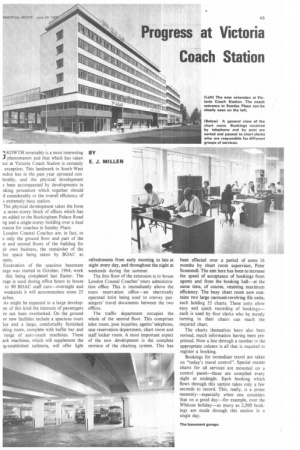Progress at Victoria Coach Station
Page 47

If you've noticed an error in this article please click here to report it so we can fix it.
ROWTH invariably is a most interesting J phenomenon and that which has taken tee at Victoria Coach Station is certainly exception. This landmark in South-West mdon has in the past year sprouted conlerably, and the physical development s been accompanied by developments in oking procedure which together should
d considerably to the overall efficiency of s extremely busy station.
The physical development takes the form a seven-storey block of offices which has en added to the Buckingham Palace Road ng and a single-storey building over a dual trance for coaches in Semley Place. London Coastal Coaches are, in fact, to e only the ground floor and part of the st and second floors of the building for .tir own business, the remainder of the ice space being taken by BOAC as lams.
Excavation of the spacious basement rage was started in October, 1964, work this being completed last Easter. The rage is used during office hours to house to 90 BOAC staff cars—overnight and weekends it will accommodate some 25 aches.
As might be expected in a large developmt of this kind the interests of passengers ye not been overlooked. On the ground or new facilities include a spacious tours ice and a large, comfortably furnished thing room, complete with buffet bar and range of auto-snack machines. These ack machines, which will supplement the ig-established cafeteria, will offer light refreshments from early morning to late at night every day, and throughout the night at weekends during the summer.
The first floor of the extension is to house London Coastal Coaches" tours administration office. This is immediately above the tours reservation office—an electrically operated hoist being used to convey passengers' travel documents between the two offices.
The traffic department occupies the whole of the second floor. This comprises telex room, post inquiries, agents' telephone, seat-reservation department, chart room and staff locker room. A most important aspect of the new development is the complete revision of the charting system. This has been effected over a period of some 16 months by chart room supervisor, Peter Scammell. The aim here has been to increase the speed of acceptance of bookings from agents and from the booking hall—at the same time, of course, retaining maximum efficiency. The busy chart room now contains two large carousel-revolving file units, each holding 55 charts. These units allow easy and quick recording of bookings— each is used by four clerks who by merely turning in their chairs can reach the required chart.
The charts themselves have also been revised, much information having been preprinted. Now a line through a number in the appropriate column is all that is required to register a booking.
Bookings for immediate travel are taken on "today's travel control". Special master charts for all services are mounted on a control panel—these are compiled every night at midnight. Each booking which flows through this section takes only a.few seconds to record. This, really, is a prime necessity—especially when one considers that on a good day—for example, over the Whitson holiday—as many as 2,500 bookings are made through this section in a single day.
























































































































